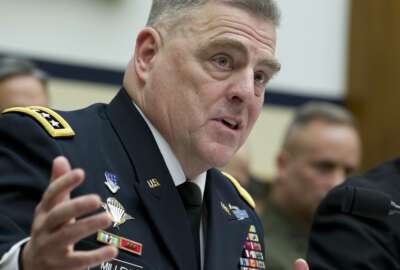
Halting programs, new investments are priorities for Army CIO
Four months into his tenure the Army CIO explains his vision for the future.
Subscribe to Federal Drive’s daily audio interviews on iTunes or PodcastOne.
The Army’s new chief information officer is only four months on the job, but he’s already laid out an ambitious set of priorities for the service to follow in the next three years.
Lt. Gen. Bruce Crawford is looking to solve some of the Army’s most pressing technological issues, which include sustaining systems that were bought on the fly during wartime and addressing weaknesses in Army networks.
In one of his first public appearances as CIO, Crawford outlined what will be on his radar during his tenure and to no one’s surprise acquisition is near the top of the list.
“We have to fundamentally change how we buy. Otherwise, whoever replaces me is going to be sitting on this very stage, probably about 32 months from now, having the exact same conversation,” Crawford said during a Dec. 5 speech at an AFCEA event in Arlington, Virginia.
Crawford said the Army needs to focus not only on what it buys, but how it buys. That’s something the Army as a whole is investigating as it continues its largest acquisition reorganization since the Vietnam era.
Part of that reorganization is focused around cyber.
“In the world of information technology, the spin cycle, if you will, more or less is generally agreed to be about 18 months. In more or less 18 months there are enough changes to software, and in some cases hardware. That spin cycle is much, much faster than the Department of Defense or the Department of the Army’s acquisition cycle,” Army Chief of Staff Gen. Mark Milley told reporters Nov. 7. “When we identify a need in the information technology area, because of the systems and processes we use it will be years before we see the actual solution. By the time we get the solution, the solution itself will be out of date.”
That’s a problem when DoD is constantly fighting off cyber threats and trying to stay up to speed with its adversaries online.
The Army is hoping its new acquisition modernization effort can make the tech buying process easier in the future.
“The whole purpose behind Modernization Systems Command and all the acquisition reforms is to rapidly and radically speed up the acquisition of capabilities, not just information, but all the capabilities as well, at a much, much faster rate,” Milley said.
Milley said getting down to the 18-month cycle is an ambitious goal, but he believes the Army can get to a lower acquisition turnaround time.
Until the Army can fix the “how” of how it buys, the service has certain “whats” it wants to invest in and Crawford was not shy about reaching out to industry for their help.
“I would take a look at the mobile ad hoc networking market that literally is growing every day before our eyes. If I’m in the cybersecurity or cyberspace operations business, the endpoint security type business, I’d be looking real hard at that as a market. Not just this radio, this cabinet, this antenna because that’s kind of how it’s being used now, as a system. A system that can be stood up and taken down in a moment’s notice,” Crawford said.
He added the other area the Army is interested in is anti-jamming satellite communications.
“The Army has become hyper-reliant on satellite communications and that’s a fact,” Crawford said. “That’s a significant vulnerability for us right now.”
Crawford said the Army is about three years away from a solution to a long-term solution to the issue.
Another area of investment potential for the Army is reducing the electromagnetic signals of command posts.
“You might say that’s been around forever. Not so fast. … What I’m after is kind of the game changing technology,” Crawford said. “What we’re really looking for is the ability to hide in plain sight. The ability to allow the command post to hide amongst the ambient noise.”
Outside of investments, Crawford wants the Army to get on board with enterprise systems that will last into the future.
During wartime, the Army quickly bought a lot of systems that were needed for the warfighters, but in that haste it didn’t build in plans for those systems to expand with the service.
“The good news story is we bought a lot of kit and we got it in the hands of the warfighter. The bad news is all of that is because of how we bought it, it didn’t go through the normal process because we needed to work quickly. Things like architecture did not get done, areas of significant consideration like life cycle cost and life cycle sustainment training weren’t considered as upfront as they should have,” Crawford said.
Those things are coming back to bite the Army now, especially when it comes to funding. Crawford is trying to halt the programs that are wasting money, and fix the ones that are in need of attention.
“This discussion is on what should we keep, what things we can build upon and what needs to stop?” Crawford said. “If we are allowed to halt the programs we actually want to halt, then our ability to invest in [Fiscal] 2018 will be OK.”
Copyright © 2024 Federal News Network. All rights reserved. This website is not intended for users located within the European Economic Area.
Scott Maucione is a defense reporter for Federal News Network and reports on human capital, workforce and the Defense Department at-large.
Follow @smaucioneWFED
Related Stories





